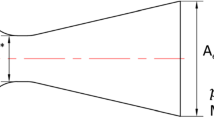Abstract
An experimental study was conducted to investigate the water entry phenomenon. A facility was designed to carry out the tests with the entry velocities of around 352 m/s. Visualization, pressure measurement, velocity measurement and underwater impact test were performed to investigate the hydroballistic behavior of the underwater moving body, the underwater flow field, the supercavitation, etc.. This study shows that the motion of a high-speed underwater body is strongly three-dimensional and chaotic. Furthermore, it is found that the distribution of the trajectory deflection of the underwater projectile depends on the depth of water. It is also found by measuring the deformation on a witness plate submerged in water, that the impact energy of an underwater projectile is reduced as it penetrates deeper into water.
Similar content being viewed by others
References
Worthington AM, Cole RS. Impact with a liquid surface studied by the aid of instantaneous photography (Part II).Phil Trans Roy Soc London Ser A, 1990, 194: 176–199
May A, Woodhull JC. Drag coefficients of steel spheres entering water vertically.J Appl Phys, 1948, 19: 1109–1121
May A. Effect of surface condition of a sphere on its water-entry cavity.J Appl Phys, 1951, 22: 1219–1222
May A. Vertical entry of missiles into water.J Appl Phys, 1952, 23: 1362–1372
Abelson HI. Pressure measurements in the water-entry cavity.J Fluid Mech, 1970, 44: 129–144
Abelson HI. A prediction of water-entry cavity shape.Trans ASME, Journal of Basic Engineering, 1971, 93: 501–504
Eroshin VA, Konstantinov GA, Romanenko NI, Yakimov YuL. Experimental determination of the pressure on a disk entering a compressible fluids at an angle to the free surface.Izv Akad Nauk SSSR, Mekh Zhid I Gaza, 1988 (2) (March–April): 21–25
Verhagen JHG. The impact of a flat plate on a water surface.J Ship Resh, 1967, 11: 211–223
Lewison G, Maclean WA. On the cushioning of water impact by entrapped air.J Ship Resh, 1968, 12: 116–130
Koehler BR, Kettleborauh CF. Hydrodynamic impact of a falling body upon a viscous incompressible fluid.J Ship Resh, 1977, 21: 165–181
Moghisi M, Squire PT. An experimental investigation of the initial force of impact on a sphere striking a liquid surface.J Fluid Mech, 1981, 108: 133–146
Cointe R. Two-dimensional water-solid impact.Trans ASME, Journal of Offshore Mechanics and Arotic Engineering, 1989, 111: 109–114
Kato Y. Cavitation. Tokyo: Maki Bookshop, 1979. 161–162
Shi HH, Takami T, Itoh, M. Trajectory deflection of underwater high-speed moving body by three-dimensional supercavitation. In: Proc. 35th Joint Meeting of Chubu & Kansai Branches of JSASS, Nagoya, Japan, 1998. 35–36
Takami T, Shi HH, Itoh M. Entry of fast blunt body into water. In: Proc.47th General Meeting of Tokai Branch of JSME. Nagoya, Japan, 1998, 157–158
Shi HH, Itoh M. Generation of high-speed liquid jet from a rectangular nozzle.Trans Japan Soc Aero Space Sci, 1999, 42: 195–202
Shi HH. Fast water entry of blunt solid projectile. In: Proc. 74th JSME Spring Ann. Meeting, Tokyo, 1997, 6: 1–4
Korobkin A. Blunt-body impact on a compressible liquid surface.J Fluid Mech, 1992, 244: 437–453
Watanabe R, Fujii K, Higashiura F. Computational analysis of the unsteady flow induced by a projectile overtaking a preceding shock wave.Trans Japan Soc Aero Space Sci, 1998, 41: 65–73
Young JO, Holl JW. Effect of cavitation on periodic wakes behind symmetric wedges.Trans ASME, J of Basic Engng, 1966, 88: 163–176
Knapp RT, Daily JW, Hammitt FG. Cavitation. New York: McGraw-Hill, 1970, 153–217
Wade RB, Acosta AJ. Experimental observations on the flow past a plano-convex hydrofoil.Trans ASME, J of Basic Engng, 1966, 88: 273–283
Shi HH, Takami T. Some progress in the study of water entry phenomenon.Experiments in Fluids, 2001, 30 (in print)
Ito H, Honda H. Fluid Mechanics. Tokyo: Maruzen Co.,Ltd., 1981, 24–25
Taylor GI. The use of flat-ended projectiles for determining dynamic yield stress.Proc Roy Soc London Ser A, 1948, 194: 289–299
Gilbarg D, Anderson RA. Influence of atmospheric pressure on the phenmena accompanying the entry of spheres into water.J Appl Phys, 1948, 19: 127–139
Author information
Authors and Affiliations
Additional information
The project supported by Japan Society for the Promotion of Science under a Grant-in-Aid for Scientific Research (C) (Grant No. 12650162)
Rights and permissions
About this article
Cite this article
Honghui, S., Takami, T. Hydrodynamic behavior of an underwater moving body after water entry. Acta Mech Sinica 17, 35–44 (2001). https://doi.org/10.1007/BF02487768
Received:
Revised:
Issue Date:
DOI: https://doi.org/10.1007/BF02487768




